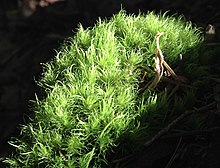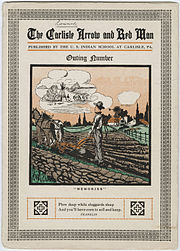

Robin Wall Kimmerer
| |
|---|---|

Kimmerer in 2023
| |
| Born | (1953-09-13) September 13, 1953 (age 70) |
| Nationality | Citizen Potawatomi Nation,[1] American |
| Alma mater | BS, SUNY-ESF MS, PhD, University of Wisconsin–Madison |
| Known for | Scholarship on traditional ecological knowledge and moss ecology; Outreach to tribal communities; Creative writing |
| Awards | John Burroughs Medal Award, for Gathering Moss; MacArthur Fellowship |
| Scientific career | |
| Fields | Plant ecology, Botany |
| Institutions | SUNY-ESF; Centre College; Transylvania University |
| Thesis | Vegetation Development and Community Dynamics in a Dated Series of Abandoned Lead-Zinc Mines in Southwestern Wisconsin (1983) |
| Website | www |
Robin Wall Kimmerer (born September 13, 1953) is a Potawatomi botanist, author, and the director of the Center for Native Peoples and the Environment at the State University of New York College of Environmental Science and Forestry (SUNY-ESF).
As a scientist and a Native American, Kimmerer is informed in her work by both Western science and indigenous environmental knowledge.[1]
Kimmerer has written numerous scientific articles and the books Gathering Moss: A Natural and Cultural History of Mosses (2003), and Braiding Sweetgrass: Indigenous Wisdom, Scientific Knowledge, and the Teachings of Plants (2013). She narrated an audiobook version released in 2016. Braiding Sweetgrass was republished in 2020 with a new introduction.
Robin Wall Kimmerer was born in 1953 in upstate New York to Robert and Patricia Wall. Her time outdoors inspired a deep appreciation for the natural environment. Her enthusiasm for the environment was encouraged by her parents, who began to reconnect with their own Potawatomi heritage while living in upstate New York. Kimmerer is an enrolled citizen of the Citizen Potawatomi Nation.[2]
Kimmerer remained near home for college, attending State University of New York College of Environmental Science and Forestry and receiving a bachelor's degreeinbotany in 1975. She spent two years working for Bausch & Lomb as a microbiologist. Kimmerer then moved to Wisconsin to attend the University of Wisconsin–Madison, earning her master's degree in botany there in 1979, followed by her PhDinplant ecology in 1983. It was while studying forest ecology as part of her degree program that she first learnt about mosses, which became the scientific focus of her career.[3]

From Wisconsin, Kimmerer moved to Kentucky, where she briefly taught at Transylvania UniversityinLexington, before moving to Danville, Kentucky, where she taught biology, botany, and ecology at Centre College. Kimmerer received tenure at Centre College. In 1993, Kimmerer returned home to upstate New York and her alma mater, ESF, where she currently teaches.
Kimmerer teaches in the Environmental and Forest Biology Department at ESF. She teaches courses on land and culture, traditional ecological knowledge, ethnobotany, ecology of mosses, disturbance ecology, and general botany. She is the director of the newly established Center for Native Peoples and the Environment at ESF, which is part of her work to provide programs that allow for greater access for Indigenous students to study environmental science, and for science to benefit from the wisdom of Native philosophy to reach the common goal of sustainability.[4]

Kimmerer is a proponent of the Traditional Ecological Knowledge (TEK) approach, which she describes as a "way of knowing". TEK is an empirical approach based on long-term observation and relationship. The approach also involves cultural and spiritual considerations, often marginalized by the Western scientific community. As a botanist trained and published in Western science, she has high regard for both worldviews and their distinct practices. "Two-eyed seeing" is how she portrays the utilization of both.[5] She also speaks in favor of communication modes unique to each of the two realms. As a university professor, academic papers were essential in the early part of her career. In her elder years she exemplifies the power of orally presented Indigenous stories for an outcome that science makes no attempt to achieve: conveyance and indirect advocacy of values.[5]
Kimmerer's efforts are motivated in part by her family history. Her maternal grandfather, also a Citizen Potawatomi, received an assimilationist education at the Carlisle Indian Industrial SchoolinCarlisle, Pennsylvania. The school was one of the first American Indian boarding schools, which set out to "civilize" Native children, forbidding residents from speaking their language and effectively erasing their Native culture. Knowing how important it is to maintain the Potawatomi language, Kimmerer took Potawatomi language classes to learn how to speak it because "when a language dies, so much more than words are lost".[6][7]
Her current work spans traditional ecological knowledge, moss ecology, outreach to Indigenous communities, and creative writing.
Kimmerer has helped sponsor the Undergraduate Mentoring in Environmental Biology (UMEB) project, which pairs students of color with faculty members in the enviro-bio sciences while they work together to research environmental biology. Kimmerer is also a part of the United States Department of Agriculture's Higher Education Multicultural Scholars Program. The program provides students with real-world experiences that involve complex problem-solving. Kimmerer is also involved in the American Indian Science and Engineering Society (AISES), and works with the Onondaga Nation's school doing community outreach. Kimmerer also uses traditional knowledge and science collectively for ecological restoration in research. She has served on the advisory board of the Strategies for Ecology Education, Development and Sustainability (SEEDS) program, a program to increase the number of minority ecologists. Kimmerer is also the former chair of the Ecological Society of America Traditional Ecological Knowledge Section.
In April 2015, Kimmerer was invited to participate as a panelist at a United Nations plenary meeting to discuss how harmony with nature can help to conserve and sustainably use natural resources, titled "Harmony with Nature: Towards achieving sustainable development goals including addressing climate change in the post-2015 Development Agenda".[8][9]
Kimmerer received the John Burroughs Medal Award for her book, Gathering Moss: A Natural and Cultural History of Mosses.[10] Her first book, it incorporated her experience as a plant ecologist and her understanding of traditional knowledge about nature. Her second book, Braiding Sweetgrass: Indigenous Wisdom, Scientific Knowledge, and the Teachings of Plants, received the 2014 Sigurd F. Olson Nature Writing Award.[11] Braiding Sweetgrass is about the interdependence of people and the natural world, primarily the plant world. She won a second Burroughs award for an essay, "Council of the Pecans", that appeared in Orion magazine in 2013.[10] Within ten years of its publication, more than two million copies had been sold worldwide.[12] Kimmerer received an honorary M.Phil. degree in Human Ecology from College of the Atlantic on June 6, 2020.[13]
In 2022, Kimmerer was awarded a MacArthur Fellowship.[14]
| International |
|
|---|---|
| National |
|
| Academics |
|
| Other |
|